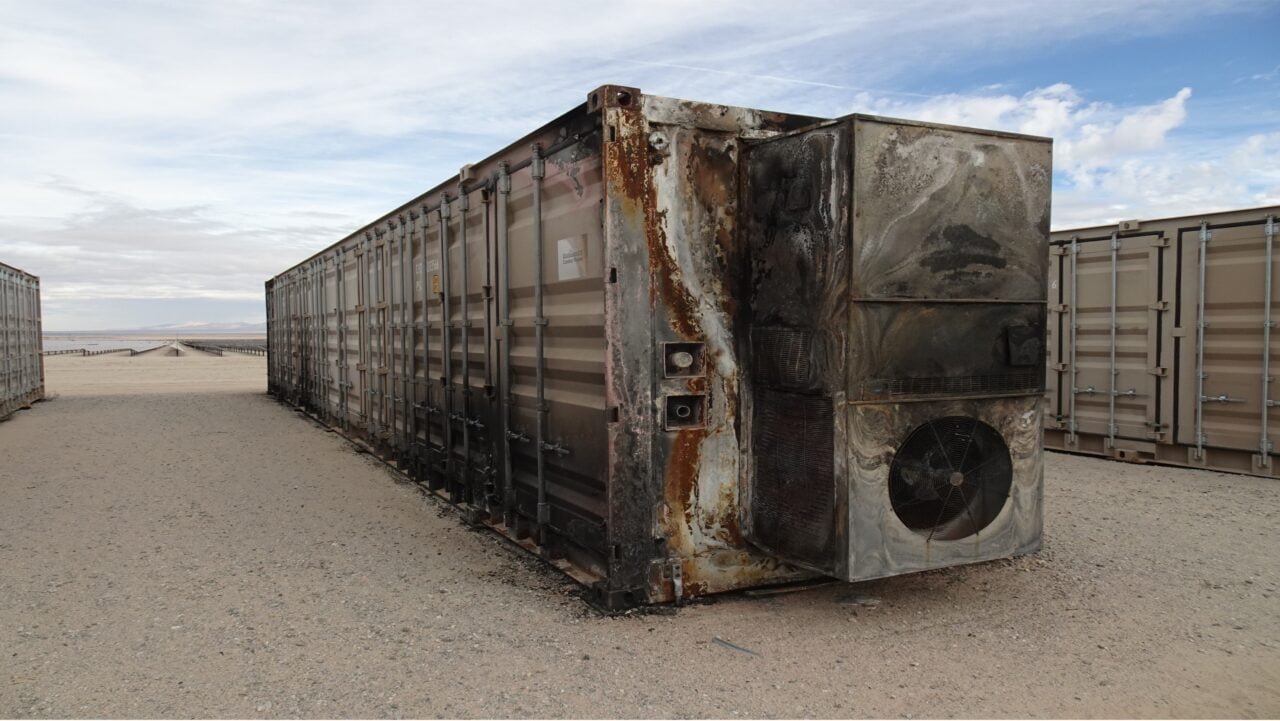“Batteries are just booming, and so it’s been fantastic, really interesting, to ramp up and to get more familiar with this asset class and to assist our underwriters, to make sure that they have the tools that they need to do their job,” Shinn said in an interview at last month’s RE+ clean energy trade show.
“The biggest thing that we’re looking at as an insurer is thermal runaway risk.”
Shinn wrote a deep dive article on BESS insurance and risk mitigation for the most recent edition of our quarterly journal, PV Tech Power (Vol.40), along with co-authors Michael Cosgrave and Ross Kiddie, who work for insurance broker Renewable Guard.
The article explained that the overall rate of failure incidents at BESS facilities is falling, but described thermal runaway, which happens when a battery cell “enters an uncontrollable, self-heating state,” as a critical safety challenge.
Thermal runaway situations can escalate from a single cell burning to engulfing enclosures or even whole systems by propagating from one rack or unit to the next.
BESS modules and enclosures are designed to prevent propagation, and in recent incidents, such as at a San Diego Gas & Electric (SDG&E) facility in Escondido, California, in September or developer Genex Power’s 100MWh Bouldercombe project in Australia during its commissioning phase about a year earlier, only single containers affected directly by thermal runaway were destroyed.
Jurisdictions and industry are learning from incidents
Therefore, while the impact of thermal runaway can be limited, no one wants to see fires happen at battery storage systems. Shinn said kWh Analytics is keeping a close watch on fire incidents reported from around the world—and the knock-on effect they could have.
“Each time one of these fires happens, we’ve seen local jurisdictions kind of step up and say: ‘Wait a second, there’s so many more batteries coming online in my state, in my county, how are we going to deal with this?’”
Shinn cites the recent example of New York, which has come up with a set of recommendations to adapt the state’s Fire Code in recognition of the attributes of energy storage systems.
Created by a panel of experts convened across different state agencies, and with industry and outside expert input, Adam Shinn said the New York Interagency Working Group “came up with some really great recommendations.”
“It’s the same thing in Arizona, California; we’ve been seeing other jurisdictions go the same route and just learn from each of these incidents,” Shinn said.
In the article for PV Tech Power, ‘Behind the spark: Insuring battery storage,’ Shinn and his Renewable Guard co-authors note that the rapid growth of the battery storage has outpaced “the development of comprehensive safety standards and regulations.”
In our interview, Shinn notes that the industry itself has “gone back and forth” on how to deal with fire events, such as whether water or gaseous fire suppression systems are more effective, or indeed, applying a ‘let it burn’ approach and allowing the affected unit to be consumed by fire, in the knowledge that it won’t propagate in those circumstances.
In the PV Tech Power article, the authors note that from 2017 and 2018, following a spate of fires in South Korea, the industry shifted towards gaseous fire suppression systems in enclosures or dedicated BESS rooms.
“The theory was simple: remove oxygen from the environment to suppress fires effectively. However, the limitations of this approach became apparent with the APS Surprise, Arizona event in 2019, where quelled fires reignited upon the reintroduction of oxygen into the system,” Shinn, Cosgrave and Kiddie wrote.
“In response to the Surprise, AZ incident, many fire departments and authorities began requiring water-based fire protection systems for BESS installations. Yet, several events since 2020 have revealed flaws in relying solely on water-based systems, particularly in remote locations where water availability can be limited.”
‘Fast-moving industry’
The right approach could vary from jurisdiction to jurisdiction and from project to project, Shinn said, and the article goes on to explain that system-side technologies like battery management system (BMS) hardware and software is becoming more sophisticated at managing and monitoring thermal events.
Likewise, insurance for energy storage systems is becoming more advanced as the industry progresses and deployments grow.
One recent interesting move was from data analytics company ACCURE, which leveraged its software that monitors batteries from cell level to estimate state of health (SoH), state of charge (SoC) and other metrics to get improved insurance terms for asset owner Gore Street Capital’s energy storage fund.
ACCURE and Gore Street took part in a webinar on that subject with this site, while rival analytics firm TWAICE has launched a similar offering with energy and infrastructure specialty insurance broker NARDAC.
kWh Analytics partnered with speciality insurer and reinsurer Aspen Insurance in early 2023 to begin offering property insurance for renewables. In April of this year, the pair expanded their capacity agreement, which meant kWh Analytics’ ability to underwrite projects increased to US$75 million per project.
“A big part of my work has just been to help our underwriters get up to speed on what’s going on out in the industry, and it’s a very fast-moving industry,” Adam Shinn said.
As well as being fast-moving, there’s a big divergence in business practices and the kWh Analytics data manager says there’s a “wide range in submission quality” that the insurer receives from developers seeking coverage.
“The best submissions will have Hazard Mitigation Analysis reports, and they’ll have Emergency Response Plans (ERPs). They’ll have Independent Engineer reports. They’ll have a wealth of information that we could lean on to make sure that we understand the risk,” Shinn says.
“On the other end of the spectrum, there are submissions with a really light amount of information, very basic: this is the manufacturer, this is how large—and that’s it. So, our underwriters are tasked with dealing with those situations and trying to optimise the best terms for the client.”







